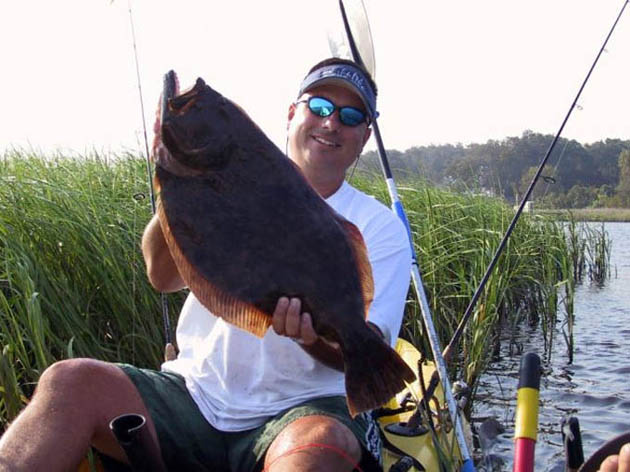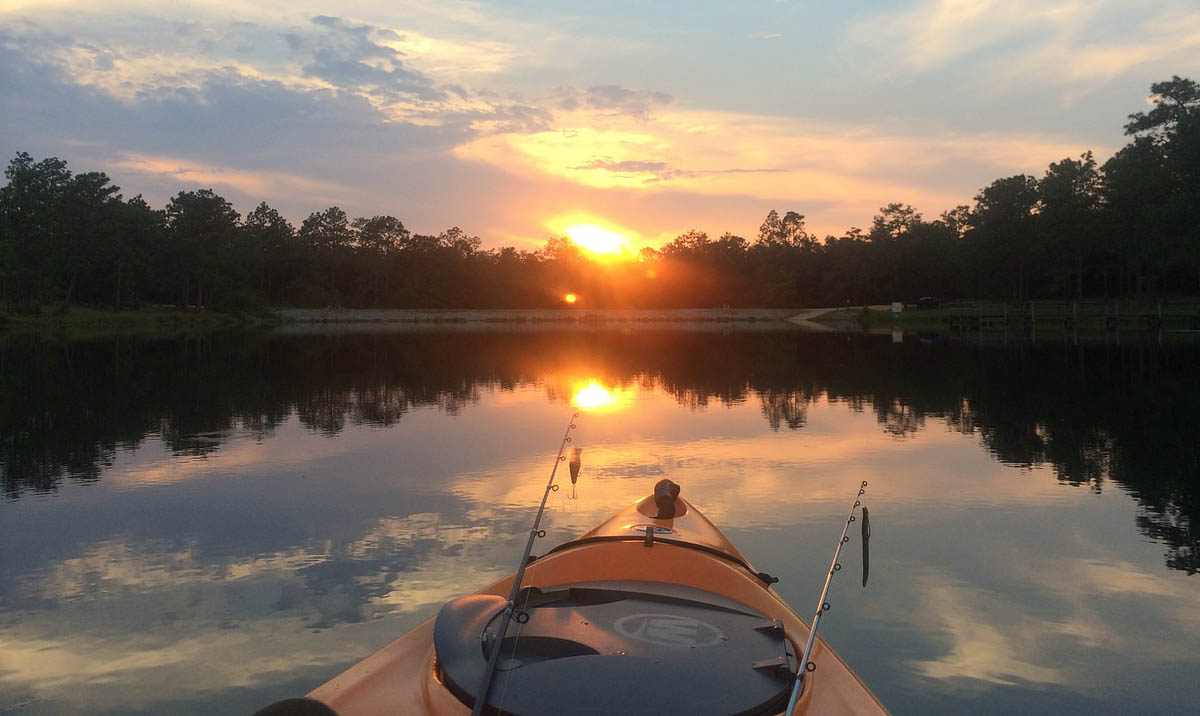The most challenging fish to target
Flounder are one of the most challenging fish to target in Northeast Florida from a kayak. These yummy wild looking fish are crafty, sneaky, ambush predators and will test all your skills from how to equip your kayak, rig your tackle, fish for the bite, work the fight, and finally land the fish.
The most important thing you can take in your kayak is a quality net, around four feet in length and with a good wide mouth. If you are fishing for the dinner table you will also need a good way to take those flounder home. I prefer a soft cooler or a kayak-specific soft cooler like the Kayak Fish Bag from Creative Feathers Studio. While stringers do work flounder on a stringer often become a real drag as they ultimately drown while you are paddling and with open mouth effectively become an anchor chute. And of course there are always those stringer “malfunctions” such as when it’s not tied off well or when a hungry predator decides it looks like an easy meal. Finally make sure you have a measuring stick to insure your flattie is legal.

Ryan Jones with a whopper of a door mat flounder.
Now that our kayak is rigged we need to select some tackle. On a kayak the tackle choices are pretty similar to fishing from shore – a 7′ medium action spinning rod with a regular tip works well whether you are fishing with live bait or artificial. I’ve found that you want a rod with a forgiving tip so you have time to handle the hook set on your own terms – a fast responsive tip often leads to missed opportunities as it causes the line tension to load up before the flounder has had time to digest and get the hook beyond the softer tissues around it’s mouth. For line I use 12-20lb braid or 12lb monofilament.
The most common live baits for flounder are mud minnows, finger mullet, and of course shrimp. Popular terminal setups for live bait are either a fish finder rig with just enough weight above the swivel to enable you to feel the bait on the bottom (usually ½-1 oz) or a medium gap jig head. With the fish finder tie 12-18″ of fluoro or mono leader to the swivel and use a wide bend hook in the size 2 to 2/0 range. Wide bend hooks hold the bait better and fit a flounder’s mouth with ease. Hook the live minnow through the lips and the finger mullet through a nostril and either fish it slowly across the bottom or dead stick it and let it swim on its own.
If you are prefer to fish with artificials a medium gap jig head or standup jig head with a soft jerk bait or swim bait works well. The standup jig is particularly deadly with a soft tube bait because it will stand the tube up as it bumps across the bottom and flutter in the current. Standard jigs work well with swim baits and jerk baits that you work across the bottom.
Using a kayak to flounder fish has two big advantages – the first is being able to fish and explore the estuary during the bottom of low tide cycles when bait is concentrated. The outgoing tide, dead low, and first of incoming tide are ideal cycles for finding flatties in a kayak. The second large advantage is one that seems like a disadvantage at times – because you can’t get up and run the motor to go from spot to spot you slow down and cover an area more thoroughly. I can’t tell you how many times I’ve been surprised by continuing to work an area and learning that fish are not always where we expect them to be!
With eyes on top of their head, proportionally large mouth and teeth, and their chameleon-like ability to change their spots to match the surrounding bottom features, flounder are ideally adapted ambush predators, preferring to lie semi-buried in the sand or sediment, waiting for unsuspecting baitfish to swim by.
To ambush the ambusher the kayak angler needs to get down current of a potential flattie location, and cast the bait up current and work it down current bumping the bottom so it emulates prey being delivered to the flounder. So think like a flounder and look for structure and current flow that make good ambush points like creek mouths, points, oyster bars, eddies, and those tiny little rivulets and cups in the marsh that empty from the grass over mud to the main channel.
A flounder bite usually comes in two varieties – you will either feel a quick bump followed by slack line, or you may feel as if the line is snagged. The quick bump and then slack line is usually a flounder rising up from the bottom to eat a prey that has drifted overhead, and then settling back to the bottom to digest it. It’s rare to get a flounder bite that hits your bait and instantly runs like a trout might. As a result you want to leave slack in the line when you detect that bump, let the flounder digest the bait (many people count to ten), and then set the hook.
In the second case when you feel like your line might be hung up on a rock or an oyster, once again it is often a flounder. In this situation you likely did a soft hook set when you detected the ‘snag’, so reel slowly and steadily not allowing slack into the line. Often the flounder will just come with you across the bottom until under the kayak, but when you try to get him up off the bottom the fight starts.
Now that you have that flounder on your hook it’s time for the toughest part – actually landing the flounder on your kayak. I can’t tell you how many stories I’ve read of people having flounder do the old self-release right at the kayak – and the key to successful landing is to be prepared and have a plan. Never try to land a flounder in a kayak by using a fish grip or jacking the fish out of the water into the kayak. Always assume you do not have a great hookset and treat that flounder with a lot of respect.
Before you start fighting the flounder vertically you need to have your landing net ready and I don’t just mean on the kayak I mean in your lap. While you fight the flounder vertically keep the rod tip low (no high sticking!) with tension and put the tip in the water during the fight to control the fish. As a right hander I will have the rod in my right hand as the fish comes up and attempt to net the flattie with my left hand on the left side of the kayak. This gives me the best reach with the net. Also I get the net under the flounder down in the water and never want to have the flounder breach the surface. Ideally I get the net under the flattie when it is within a foot of the surface. Then the fight is over.
Just because the flounder is in your net in your lap does not mean the fight is over. They have an awesome jaw so be careful when getting the hook out. I usually put the flounder on a fish grip while in the net, and then extract the hook while it’s still in the net. I have had way too many flounder launch themselves with a single thrust over the edge of the kayak back into the water at the most unsuspecting moment.
If you need to take a picture of the flounder on a measuring stick for a catch-photo tournament format make sure you have something to help you restrain the flounder for the measurement. Use the net as long as possible and have it in a position to impede a hasty escape. Finally whether you are stringing the flounder or putting it in a cooler don’t breathe easy until the door is shut.
For more information on kayak fishing in the northeast Florida area including detailed launches, routes, and fishing reports visit www.JaxKayakFishing.com, Jacksonville’s kayak fishing community.
Captain Mike Kogan (a.k.a. KayakMike) is a USCG licensed charter captain. He runs www.JaxKayakFishing.com, North Florida’s Kayak Fishing Community and hosts the Jacksonville Kayak Fishing Classic, the world’s largest kayak fishing tournament.

